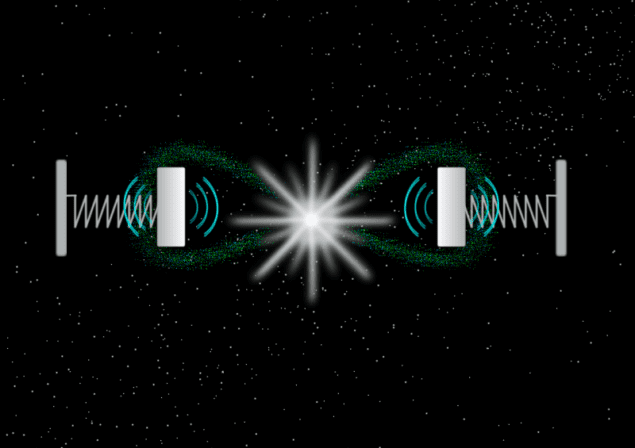Physicists propose how to entangle macroscopic objects using pulses of light
19 Jun 2020
Physicists at Imperial College London, UK, and Stockholm University, Sweden, have proposed a new way of creating entanglement between mechanical motion and an optical field, and also between two mechanical oscillators, using short pulses of light. Here research students Jack Clarke and Paulo Sahium along with group director Michael Vanner from the Quantum Measurement Lab at Imperial explain the work.
The research is reported in full in New Journal of Physics, published by IOP Publishing – which also publishes Physics World.
What was the motivation for the research?
Quantum entanglement is one of the most intriguing aspects of physics and allows objects to be more strongly correlated than is allowed classically. Albert Einstein called this perplexing behaviour “spooky action at a distance” and many objections to this radical idea were raised in the early days of quantum mechanics. Fast forward 80 years, and quantum entanglement is a now a well-established phenomenon and is routinely generated between objects such as photons, atoms and molecules.
Making an entangled state of something bigger allows us to test quantum physics on a macroscopic scale and paves the way for the development of powerful new quantum technologies, such as sensing and quantum networking. In this work, we propose a new technique to create such quantum states by using quantum optomechanics. In our scheme, light bounces off two tiny mechanical oscillators causing them to move, creating an entangled state in their motion.
What did you do in the work?
It is a very exciting time in quantum optomechanics at present, as early signatures of quantum motion of mechanical oscillators are now being observed. In this work, we theoretically proposed and analysed a powerful new approach to create entanglement between mechanical motion and an optical field, and also between two mechanical oscillators, using short pulses of light.
With this work, we have laid the foundation for future experiments in this area by showing how to both generate and, importantly, verify the entanglement. To make this a more useful study, we also dived into the details and computed the effects of optical loss and mechanical quantum decoherence on the quantum states. We are very encouraged by these results, as our schemes offer many advantages including being able to operate with weak optomechanical coupling, and being resilient to optical loss and mechanical decoherence.
What was the most interesting or important finding?
Our research is the first theoretical proposal for preparing and verifying mechanical and optomechanical entanglement in the emerging field of pulsed optomechanics. This highlights a route to observe quantum entanglement in a regime where it hasn’t been seen before.
More specifically, there are two main regimes in quantum optomechanics. One is the “resolved-sideband regime”, where light circulates inside an optical cavity for a timescale that is long compared to the mechanical period. The other is the “unresolved-sideband regime”, which allows for rapid pulsed interactions over a timescale much shorter than the mechanical period. Optomechanical entanglement has not yet been observed in this latter regime and our work makes key steps in this direction. One of the most important results from our work is that in the pulsed regime creating such entanglement looks experimentally accessible, and is robust to effects that often hinder its observation.
Why is this research significant?
Entanglement can be exploited to develop new quantum technologies such as quantum networks and quantum-enhanced force sensors. Studying it also allows us to address very fundamental questions, such as “what are the limits of quantum theory?” To these ends, a key current goal of research is to create and observe entanglement on larger and larger mass scales. Quantum optomechanics has significant potential to contribute to both areas, which helps to make it such an exciting field. This research project makes a significant step in these directions, as it opens a rich new avenue for studies of optomechanical entanglement in the pulsed regime.
What do you plan to do next?
In our research group – the Quantum Measurement Lab – we pursue a combination of experimental and theoretical quantum science to advance our understanding of the foundations of physics and to leverage this understanding to develop new quantum technologies.
We will build on our research in three key ways. First, our results have sparked new theoretical questions on optomechanical entanglement creation and its verification, which we have begun investigating. Second, it’s a very exciting time for our group at present as our new lab in London has completed a refurbishment phase and we are eager to build experiments in these directions once the current coronavirus pandemic is over. Third, we hope our research in pulsed optomechanics inspires other experimental groups around the world and that we will engage with our global research community to initiate new collaborative projects.
from physicsworld.com 13-07-2020

Δεν υπάρχουν σχόλια:
Δημοσίευση σχολίου